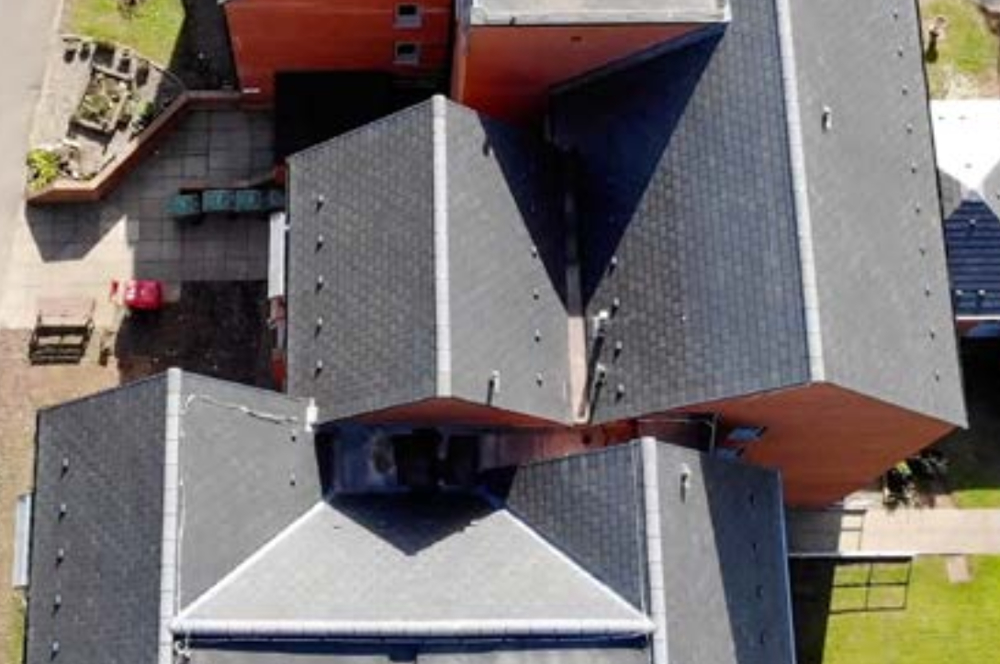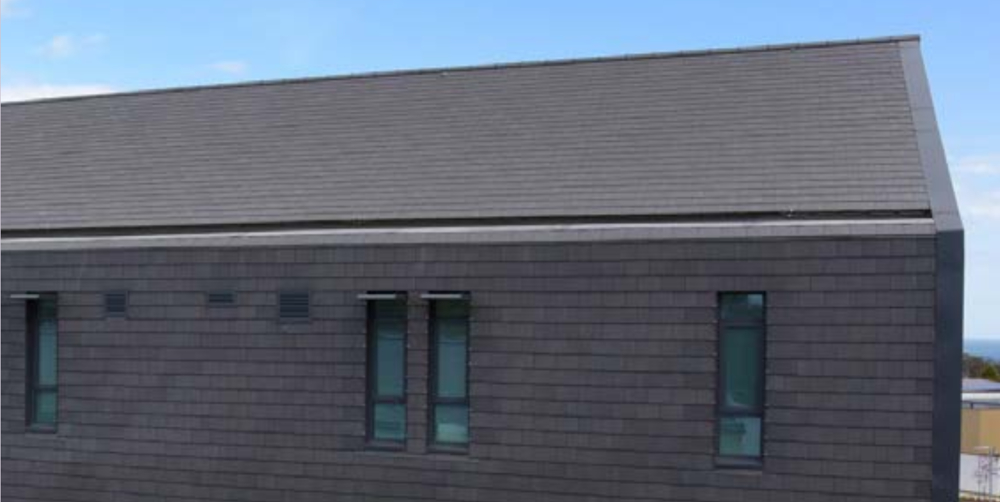The impact of recycled slate tiles
Contents |
[edit] Innovation across the decades
Over 40 years, Cambrian has earned its position as the industry’s leading engineered slate tile. Let’s walk through its history – from top secret development through to its impact on people and planet. Slate has been used as a building material for centuries and it continues to adorn homes up and down the country. Its unique colour and characteristics provide an aesthetic that can’t be achieved with many modern materials. There are many areas across the country that pride themselves on the aesthetic of slate-topped properties, and conservation areas that demand that a slate aesthetic continues to be specified to this day.
However, as a natural product, the industry must be conscious of the use of slate, and we must look to preserve this resource for the future. In fact, many of the slate quarries in Wales are now protected under UNESCO status and most of the slate used in the UK is now imported from countries such as Spain and China, adding further environmental considerations to its use.
[edit] Engineered slate tiles
So, when Redland first began developing the Cambrian Slate tile in the early-80s, it was well ahead of its time. Fast-forward to today and it’s the leading engineered slate tile in the industry and plays a transformative role in new build and renovation projects both here in the UK and around the world.
Innovation is never straightforward, and when it’s a world-first that’s being developed, processes become a top secret operation. For Redland, that meant setting up a brand-new production facility in Wales – close to where the raw material was being sourced – which remains the heart of production to this day.
Mandy Ellmer, Quality Manager for BMI UK & Ireland, a new recruit at the time, having just left school, was one of the first to join the development team. She recalls: “As the factory was still being built, the product was being developed behind a big green tarpaulin – and you had to be granted access to see behind the curtain. There was one time when I had to drive through the night to collect a catalyst, before being met by the team in the misty factory car park in the Brecon Beacons – it really did feel like a covert mission!”
The Cambrian Slate represented a truly innovative approach to innovation. By taking some of the large quantity of waste slate that is generated in the slate quarrying process and turning it into an attractive, durable slate tile, the development was a world-first. In practice, the Cambrian Slate tile made it possible to balance traditional slate aesthetics with engineered performance and environmental consciousness.
[edit] Recognition for innovation
Within a decade of its development, Cambrian Slate was recognised for its innovation and received the Queen’s Award for Technological Achievement in 1991. Mandy added: “When Cambrian won the Queen’s Award, it felt like a reward for all the hard work the team had put in – and going to Buckingham Palace to meet the Queen was an amazing experience!”
From its purpose-built production facility in Wales, Cambrian Slate has quietly transformed how the roofing industry thinks about, and uses, the material.
Aesthetics are, of course, key where the Cambrian Slate is concerned. The tile is manufactured using moulds taken from local slates to create the classic slate appearance of a riven surface and thin leading edge. And with the high natural slate content, it means the Cambrian tile can deliver a genuine Welsh slate look. In fact, many projects on Listed Buildings and in natural slate Conservation Areas have been approved for use with Cambrian over the years.
As an engineered tile, Cambrian can also offer some advantages that natural slate can’t. It is designed to be easy to install – something which is aided by its uniformity and lightweight characteristics. Consistent size and quality allow roofers to install Cambrian quickly and easily with no grading required, while interlocking edges allow the slate to be laid in the same way as an interlocking tile, speeding up installation and reducing the slates required per square metre. Alongside this, precast holes, nibs for easy hanging, and a unique three-point fixing system help to save time on site.
Aside from the on-site practicalities, Cambrian Slate can support architects and specifiers to maximise some of the environmental credentials of projects. Using 60% recycled Welsh slate, the finished product benefits from a significant carbon saving when set against alternatives that are imported from overseas.
[edit] Worldwide from Wales
The benefits of Cambrian have also been felt far beyond the UK in its 40-year history, with the innovative tile being the material of choice for buildings impacted by the 7.8 magnitude earthquake that hit New Zealand in 2014. With insurance companies leading the charge for lighter roofing materials to replace the concrete tiles commonly used in the area, Cambrian was used on many buildings to create a traditional aesthetic and deliver lightweight roofs. It is believed that lighter roofs would reduce the levels of damage should another quake hit the area in the future.
Mandy added: “To be able to look back on 40 years of Cambrian Slate, and four decades of development that have defined my career, it is fantastic to see what has been achieved. Taking a waste product and creating something truly innovative, seeing how it has transformed buildings around the world, and knowing that it has stood the test of time really does speak volumes.”
While the development of Cambrian Slate in the early-1980s signalled a new approach to sustainable slate roofs, further innovation from BMI Redland has supported its adoption on rooftops around the world. While natural slate boasts a timeless beauty which will always be in demand, the complexities of modern construction require solutions which prioritise sustainability while redefining expectations around performance, aesthetics and functionality. Cambrian fulfils this by combining the natural beauty of Welsh slate with the strength, versatility and functionality of an engineered solution.
This article appears in the AT Journal Issue 153 from Spring 2025 as 'Innovation across the decades: the impact of recycled slate tiles' and was by Mat Woodyatt, Product Manager, BMI Redland.
--CIAT
[edit] Related articles on Designing Buildings
- Battens.
- Cladding.
- Clovelly, a village changing hands and changing with the times..
- Conical roof slating.
- Crow-stepped gable.
- Delabole Slate.
- Domestic roofs.
- Limestone for building.
- Natural materials.
- Pitched roof.
- Roof coverings.
- Roof slates.
- Roof tiles.
- Roofing defects.
- Shingle roofing.
- The Pattern of Traditional Roofing.
- Thatch roofing.
- Types of roof.
- Types of stone.
Featured articles and news
Ebenezer Howard: inventor of the garden city. Book review.
The Grenfell Tower fire, eight years on
A time to pause and reflect as Dubai tower block fire reported just before anniversary.
Airtightness Topic Guide BSRIA TG 27/2025
Explaining the basics of airtightness, what it is, why it's important, when it's required and how it's carried out.
Construction contract awards hit lowest point of 2025
Plummeting for second consecutive month, intensifying concerns for housing and infrastructure goals.
Understanding Mental Health in the Built Environment 2025
Examining the state of mental health in construction, shedding light on levels of stress, anxiety and depression.
The benefits of engaging with insulation manufacturers
When considering ground floor constructions.
Lighting Industry endorses Blueprint for Electrification
The Lighting Industry Association fully supports the ECA Blueprint as a timely, urgent call to action.
BSRIA Sentinel Clerk of Works Training Case Study
Strengthening expertise to enhance service delivery with integrated cutting-edge industry knowledge.
Impact report from the Supply Chain Sustainability School
Free sustainability skills, training and support delivered to thousands of UK companies to help cut carbon.
The Building Safety Forum at the Installershow 2025
With speakers confirmed for 24 June as part of Building Safety Week.
The UK’s largest air pollution campaign.
Future Homes Standard, now includes solar, but what else?
Will the new standard, due to in the Autumn, go far enough in terms of performance ?
BSRIA Briefing: Cleaner Air, Better tomorrow
A look back at issues relating to inside and outside air quality, discussed during the BSRIA briefing in 2023.
Restoring Abbotsford's hothouse
Bringing the writer Walter Scott's garden to life.
Reflections on the spending review with CIAT.
Retired firefighter cycles world to raise Grenfell funds
Leaving on 14 June 2025 Stephen will raise money for youth and schools through the Grenfell Foundation.
Key points for construction at a glance with industry reactions.



























